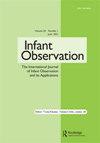Editorial
Q4 Psychology
引用次数: 0
Abstract
When Esther Bick came up with her brainwave; the practice of naturalistic psychoanalytic baby observation, she could never have expected it to spread so far, nor that its applications would become so many and so useful. This issue of the Journal, the first of 2019, contains examples of applications of Bick’s method of exceptional quality. These are descriptions and illustrations which give a clear sense of what can be understood and learnt in terms of how to use observation to assess the needs of children who have had to be removed from their birth parents, white South African children cared for by white-employed black nannies, observing oneself developing and learning as a new observation teacher, and using observation to understand the complex dynamics of treating young people with diabetes and transferring to adult medical care. Bick (1964) originally conceived of the idea that trainee child psychotherapists, and later psychoanalysts in training (Infant Observation at the Tavistock began in 1948 and, at the Institute of Psychoanalysis in 1960) would benefit from the direct experience of establishing and undertaking a regular weekly visit to observe a baby in his or her family. The explicit aim was to encourage the observer to establish the observation in negotiation with the baby’s parents, and to try, as far as possible, ‘simply’ to notice as much as possible about the baby, quietly taking in and remembering the detail of what happened in the hour. Bick wanted future child psychotherapists to have some direct experience of being with a baby. She wanted to alert them to something which came entirely naturally to Bick herself, to be in touch with the infantile in child patients and to listen sympathetically and with greater imaginative and sympathetic involvement, to mothers’ accounts of their baby (See Rustin, 2009). The observer was to try to find a place in the family home and to note whatever happened in the ordinary course of events, to be recalled by writing as detailed an account as possible soon after the observation finished. This apparently simple task was, in fact, not simple at all, as Bick knew and as Rustin (2009) amongst many others, has noted. The observer’s task of finding an appropriate position during observational visits is often excruciating. The self-consciousness, any feeling of being looked at critically which parents might have, the observer’s strong identification with the baby, the raw feeling of new-ness, all contribute. Bick was strongly aware of observers’ tendency to identify with the baby, and to feel critical of parents. She was also aware that, again as Rustin notes, (Rustin 2009) the observer needs to find a way to relate to everyone who is present, focusing on the baby without ‘acting out a role’ offered unconsciously or consciously by the family. The observer is inevitably also exposed to the emotional upheaval of the first months of life. The formal application of observation to a range of tasks and settings began with Martha Harris’s Work Discussion Seminars at the Tavistock. My own first experience of work discussion was as a secondary school teacher when I was helped to understand what was going on in my pastoral work with troubled adolescents. I was helped, along with fellow students from a variety of settings, to develop what is sometimes known as an ‘observational stance’ in my interactions with the young people. Taking编辑
当埃丝特·比克想出她的脑电波时;自然精神分析婴儿观察的实践,她从来没有想到它会传播到这么远,也没有想到它的应用会变得如此广泛和有用。本期《华尔街日报》是2019年的第一期,包含了Bick方法卓越质量的应用实例。这些描述和插图清楚地说明了在如何利用观察来评估不得不离开亲生父母的儿童的需求、由白人雇佣的黑人保姆照顾的南非白人儿童、作为一名新的观察老师观察自己的发展和学习方面,可以理解和学习什么,并利用观察来了解治疗年轻糖尿病患者和转为成人医疗的复杂动态。Bick(1964)最初设想,受训的儿童心理治疗师和后来接受培训的精神分析学家(Tavistock的婴儿观察始于1948年,1960年在心理分析研究所)将受益于建立和进行每周定期访问以观察其家庭中婴儿的直接经验。明确的目的是鼓励观察者与婴儿的父母协商建立观察结果,并尽可能“简单”地注意到婴儿的情况,安静地接受并记住一小时内发生的事情的细节。比克希望未来的儿童心理治疗师能有一些与婴儿在一起的直接体验。她想提醒他们注意比克自己完全自然的事情,与婴儿期患者保持联系,以同情的方式倾听母亲对婴儿的描述,并以更大的想象力和同情心参与其中(见Rustin,2009)。观察者将试图在家中找到一个位置,并记录下日常事件中发生的一切,并在观察结束后尽快写下尽可能详细的描述来回忆。事实上,正如Bick和Rustin(2009)等人所指出的那样,这项看似简单的任务一点也不简单。观察者在观察访问期间寻找合适位置的任务往往是艰巨的。自我意识,父母可能有的任何被批判性看待的感觉,观察者对婴儿的强烈认同,对新事物的原始感觉,都是有贡献的。比克强烈意识到观察者倾向于认同婴儿,并对父母持批评态度。她也意识到,正如鲁斯廷所指出的,(鲁斯廷,2009年)观察者需要找到一种与在场的每一个人建立联系的方式,专注于婴儿,而不是“扮演一个家庭无意识或有意识地提供的角色”。观察者也不可避免地暴露在生命最初几个月的情感剧变中。观察在一系列任务和环境中的正式应用始于Martha Harris在Tavistock举办的工作讨论研讨会。我自己的第一次工作讨论经历是作为一名中学教师,当时我被帮助了解了我与问题青少年的田园工作中发生了什么。在我与年轻人的互动中,我和来自各种环境的同学们一起被帮助发展了有时被称为“观察立场”的东西。拿
本文章由计算机程序翻译,如有差异,请以英文原文为准。
求助全文
约1分钟内获得全文
求助全文

 求助内容:
求助内容: 应助结果提醒方式:
应助结果提醒方式:


